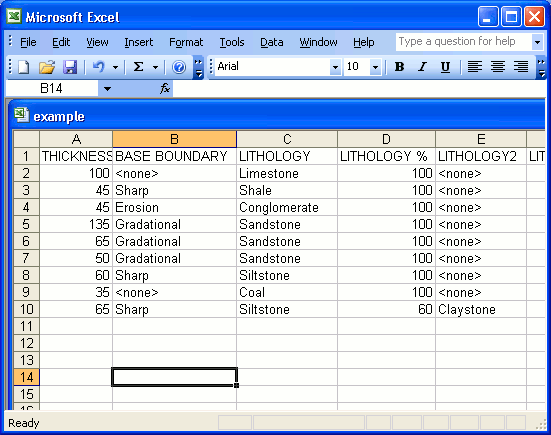Create a log by importing a CSV file
SedLog takes as input data files containing the sediment data in
CSV format. CSV (or comma-separated values; also known as a
comma-separated list or comma-separated variables) file format is
a file type that stores tabular data. It is a delimited text file
data format that has fields/columns separated by the comma
character and records/rows separated by newlines. Fields that
contain a special character (comma, newline, or double quote),
must be enclosed in double quotes. The CSV file format does not
require a specific character encoding, byte order, or line
terminator format making it platform independent. Bellow is a
sample CSV file opened by a text editor:
"THICKNESS
(CM)","BASE
BOUNDARY","LITHOLOGY","LITHOLOGY %","GRAIN SIZE BASE","GRAIN
SIZE TOP","SYMBOLS IN BED"
100,"","Limestone",100,"vf","vf","Intense bioturbation"
45,"Sharp","Shale",100,"clay","clay",""
45,"Erosion","Conglomerate",100,"pebble","granule","Cephalopods"
135,"Gradational","Sandstone",100,"vc","m","Trough cross
bedding" 65,"","Sandstone",100,"m","m","Planar cross bedding"
50,"","Sandstone",100,"f","f","Current ripple
cross-lamination" 60,"Sharp","Siltstone",100,"silt","silt",""
35,"","Coal",100,"","",""
65,"Sharp","Siltstone",60,"clay/silt","clay/silt","Moderate
bioturbation"
CSV files can be created or opened by any
spreadsheet application such as Microsoft Excel, OpenOffice.org
Calc, Corel Quattro Pro, etc. When you are creating an input data
file for SedLog using a spreadsheet application such as MS Excel
make sure to save it in CSV format using the Save As option not
the default one. The CSV format does not store information such as
column width, colour, etc, so when you will try to save a
spreadsheet to CSV format the spreadsheet application will warn
you that you will loose some information saving it in CSV format.
Don’t worry about it, proceed and save it as CSV. Below (see
Figure 1) you can see a screenshot of a CSV file opened in
Microsoft Excel:

Figure
1.
A CSV file opened in MS Excel

Figure
2.
Importing a CSV file to SedLog
In the Imported Columns
list box on the left of the dialog box are displayed the headers
of the columns of the imported CSV. Click on the Imported Columns list box to
select which column from the CSV file you want to import. Then use the Assign Imported Column To
combo box on the top right of the dialog box to assign the
imported column to the corresponding SedLog's log column. Only the
columns present at the Assigned
Columns box at the bottom right of the dialog box are
going to be imported.
See Also
Creating a log from scratch
Data export into other programs


